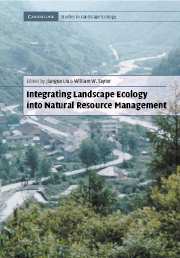Book contents
- Frontmatter
- Contents
- List of contributors
- Foreword
- Preface
- Acknowledgments
- PART I Introduction and concepts
- PART II Landscape structure and multi-scale management
- PART III Landscape function and cross-boundary management
- 7 Assessing the ecological consequences of forest policies in a multi-ownership province in Oregon
- 8 Incorporating the effects of habitat edges into landscape models: Effective area models for cross-boundary management
- 9 Aquatic-terrestrial linkages and implications for landscape management
- PART IV Landscape change and adaptive management
- PART V Landscape integrity and integrated management
- PART VI Syntheses and perspectives
- Index
- Plate Section
8 - Incorporating the effects of habitat edges into landscape models: Effective area models for cross-boundary management
Published online by Cambridge University Press: 14 January 2010
- Frontmatter
- Contents
- List of contributors
- Foreword
- Preface
- Acknowledgments
- PART I Introduction and concepts
- PART II Landscape structure and multi-scale management
- PART III Landscape function and cross-boundary management
- 7 Assessing the ecological consequences of forest policies in a multi-ownership province in Oregon
- 8 Incorporating the effects of habitat edges into landscape models: Effective area models for cross-boundary management
- 9 Aquatic-terrestrial linkages and implications for landscape management
- PART IV Landscape change and adaptive management
- PART V Landscape integrity and integrated management
- PART VI Syntheses and perspectives
- Index
- Plate Section
Summary
Introduction
Natural resource managers are increasingly charged with meeting multiple, often conflicting goals in landscapes undergoing significant change due to shifts in land use. Conversion from native to anthropogenic habitats typically fragments the landscape, reducing the size and increasing the isolation of the resulting patches, with profound ecological impacts (see Whitcomb et al., 1981; Harris, 1984; Wilcove et al., 1986; Robinson et al., 1995). These impacts occur both within and adjacent to the area under active management, creating new and extensive edges between habitat types. Boundaries established between management areas, for example, between timber harvest units or between reserves and adjacent agricultural fields, inevitably lead to differences in the quality of habitats on either side of the boundary, and a habitat edge results. Although edges are common components of undisturbed landscapes, the amount of edge proliferates rapidly as landscapes are fragmented (Fig. 8.1).
The creation of edges has important ecological implications at the individual, population, and ecosystem levels. Early ecologists and wildlife managers noted that community organization and species abundances are often markedly different near habitat edges (Leopold, 1933; Lay, 1938). Resource managers and conservation biologists have long attempted to translate these observations into managementactions,oftenbyattemptingtomaximizeorminimizetheamountof edge in some manner (e.g., Giles, 1971; Forman et al., 1976). Despite this long history of consideration and recent advances in understanding the consequences of habitat fragmentation, the development of tools for predicting these impacts has progressed slowly. In this chapter, we offer an historical perspective on attempts to address the influence of habitat edges on wildlife and ecological processes, and we describe a spatial modeling approach that can help managers quantify these effects and incorporate species-specific data into a predictive framework for comparing the likely impacts of alternative managements cenarios.
Information
- Type
- Chapter
- Information
- Integrating Landscape Ecology into Natural Resource Management , pp. 208 - 240Publisher: Cambridge University PressPrint publication year: 2002
Accessibility standard: Unknown
Why this information is here
This section outlines the accessibility features of this content - including support for screen readers, full keyboard navigation and high-contrast display options. This may not be relevant for you.Accessibility Information
- 6
- Cited by
